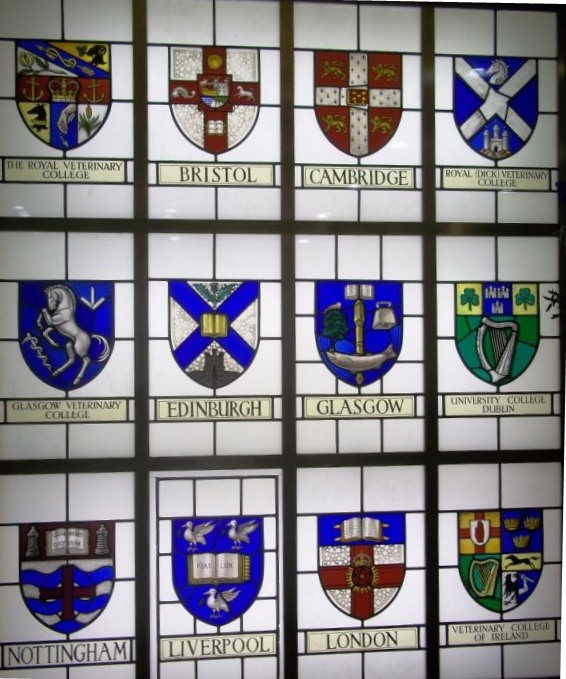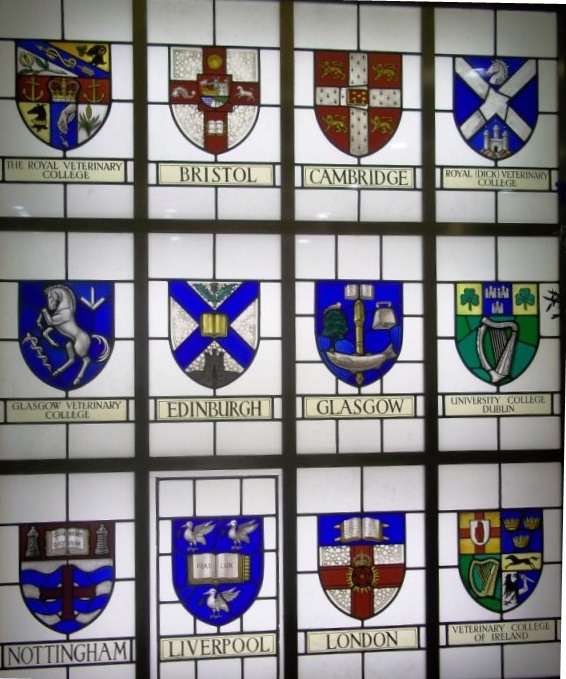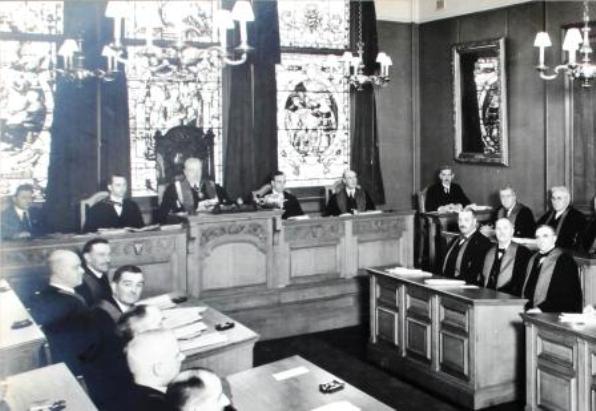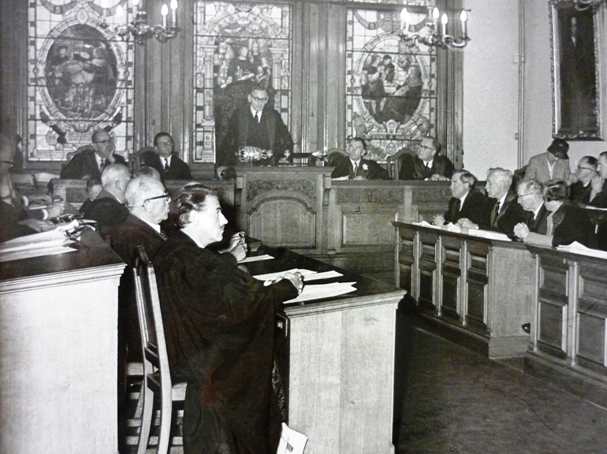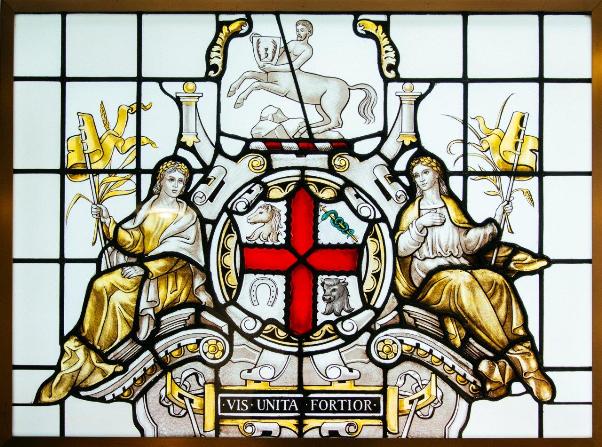The RCVS stained glass
The addition of the Coat of Arms of the University of Nottingham to the display of stained glass in the reception at Belgravia House, the RCVS HQ, has awakened interest in the history of the glass in this display and elsewhere in the building. As a result I spent several days pouring over 170 years of Council minutes to see what I could find out.
The story begins in 1884 when the College decided to knock down its existing building in Red Lion Square and erect a new home on the same site. This new building was to be ‘fitting for the home of the veterinary profession’ and tenders were invited for three stained glass windows in the Council Chamber facing on to Red Lion Square. Money was tight though and Council decided they couldn’t justify the extra expense.
The idea of having ‘coloured’ windows must have appealed to sections of the profession as the Central Veterinary Medical Society offered to pay for stained glass in the middle window. Practitioners HL Simpson and JF Simpson (prominent members of the Royal Counties Veterinary Medical Association) jointly offered another. So, whilst the building opened on 6 April 1886 with plain windows, stained glass was installed in two of them in time for the AGM a month later.
In an editorial about the new building in May 1886 The Veterinary Journal reminded ‘societies and individuals that there is much yet to be done in the way of furnishing, fitting and embellishment of their building, and that now is a good opportunity for their assistance’. Perhaps this plea was aimed at the remaining plain window in the Council Chamber?
If so it seems to have worked as the following year the Norfolk and Eastern Counties, the Western Counties and the Lincolnshire Veterinary Medical Associations agreed to jointly fund the final stained glass window. They presented the design to Council on 3 April 1888. The window would show:
‘a veterinary surgeon examining a horse, which was made to appear as jaded as possible, to carry out the idea of a sick animal. After the stable-master’s explanation about the animal, the veterinary surgeon appears to be cautioning him for the future, telling him never to leave till to-morrow what might be done to-day. There was a Latin inscription under the subject to that effect. In the background a shepherd was seen driving a flock of sheep for the veterinary surgeon to examine. The subject was surrounded by an oval interlaced with the monograms of the counties by which the window was presented’.
Finally the three windows were complete and they disappear from the records until 1941 when they are mentioned in reports of the damage caused by the bombing of Red Lion Square in the final month of the Blitz. The damage was so serious that they had to be removed and replaced by plain glass.
It was not until 1953, following payment of war damage compensation, that the windows were repaired and returned to their original position. Or were they? Photographic evidence (see below) seems to show that, for some unknown reason, the two outer windows switched sides.
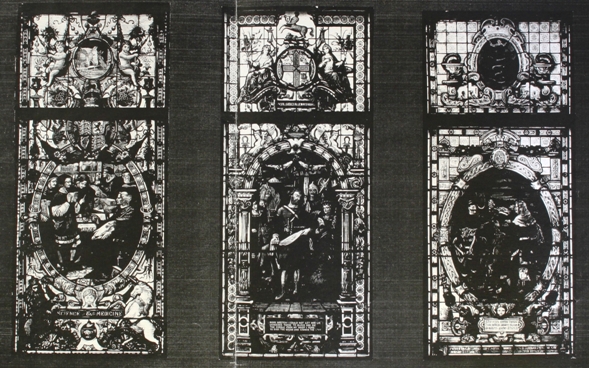
The three windows as they looked when first installed. The window depicting the sick horse is on the right.
The 1953 Annual Report also records that the idea of adding the ‘armorial bearings of the universities having veterinary schools and of the veterinary colleges which have their own bearings’ in the windows at the opposite end of the building was being considered. It was hoped that these would be paid for by ‘the universities and colleges concerned or by the alumni thereof’.
There is no record of when this happened but the six university coats of arms must have been added before 1960, when the College moved out of Red Lion Square and put the stained glass in storage, as they are mentioned in discussions about which items from Red Lion Square could be incorporated in to the new building in Belgrave Square.
In March 1962 a representative from Goddard and Gibbs (the stained glass studio where the windows were being stored) reports that it was not practicable to include the main windows in the new building but it would be possible to ‘incorporate one panel of the Royal College coat of arms [from the middle one of the three windows] and the six existing panels of the coats of arms … in the window at the garden end of the large room on the first floor’.
This was agreed and these panels, with the addition of new stained glass representations of the coats of arms of ‘the veterinary schools under the old one portal system’ (Royal Veterinary College, Royal (Dick) Veterinary School, Glasgow Veterinary College and the Veterinary College of Ireland) plus Trinity College, Dublin and University College, Dublin were installed in the Historical Library in Belgrave Square.
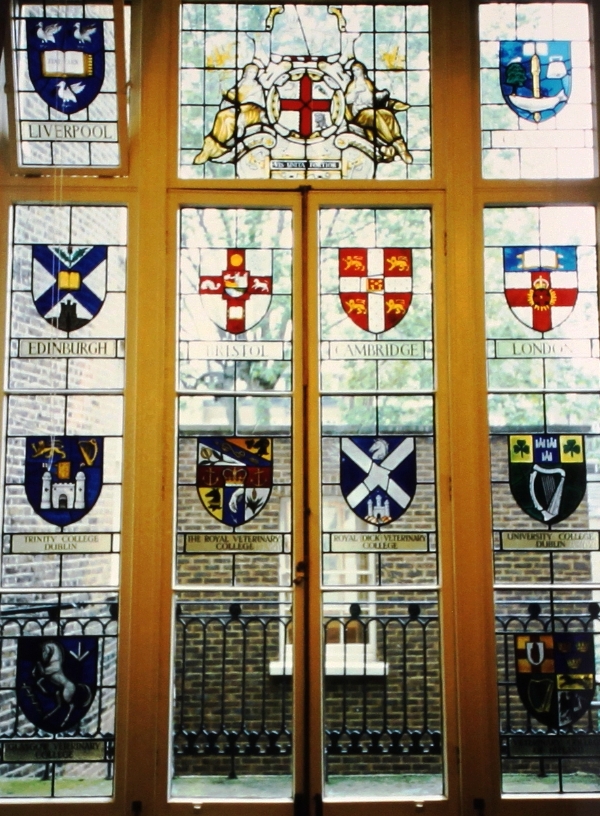
The coats of arms from the universities and veterinary schools as well as the RCVS Coat of Arms from the original middle window installed in Belgrave Square
It is the stained glass from this window that can now be seen in Belgravia House – the university coats of arms in reception and the RCVS Coat of Arms in the Members’ room.
The question of what happened to the rest of the three larger windows remains a mystery. Minutes of 1962/63 record discussions of possible homes, including a new student hostel at RVC’s Hawkshead Campus. These all fell through. The final mention of them in the official records is in October 1963 when Registrar WGR Oates reports that he has written again to the associations who presented the windows to see if they have views on their future.
You can see glimpses of the windows in Red Lion Square in a film produced by Paul Greenough MRCVS in 1960 (3.07 mins and 4.42 mins)

